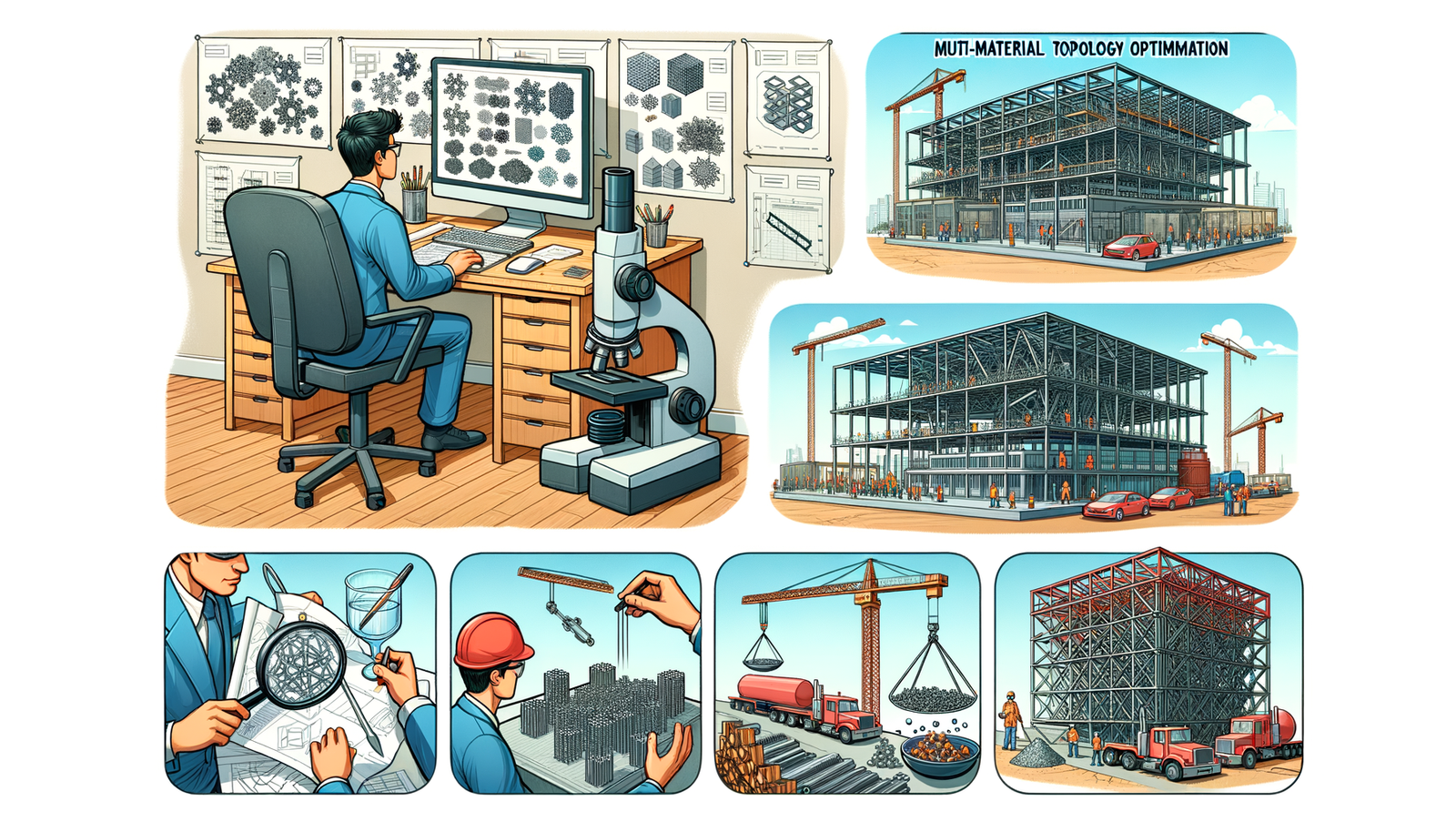Your Cart is Empty
Customer Testimonials
-
"Great customer service. The folks at Novedge were super helpful in navigating a somewhat complicated order including software upgrades and serial numbers in various stages of inactivity. They were friendly and helpful throughout the process.."
Ruben Ruckmark
"Quick & very helpful. We have been using Novedge for years and are very happy with their quick service when we need to make a purchase and excellent support resolving any issues."
Will Woodson
"Scott is the best. He reminds me about subscriptions dates, guides me in the correct direction for updates. He always responds promptly to me. He is literally the reason I continue to work with Novedge and will do so in the future."
Edward Mchugh
"Calvin Lok is “the man”. After my purchase of Sketchup 2021, he called me and provided step-by-step instructions to ease me through difficulties I was having with the setup of my new software."
Mike Borzage
Advancing Structural Design: Exploring Multi-Material Topology Optimization Techniques and Industry Applications
September 11, 2024 4 min read


Introduction to Topology Optimization
Topology optimization is a sophisticated computational technique used to design efficient, high-performance structures by optimizing material layout within given constraints. This approach yields innovative designs that are often lighter, stronger, and more efficient than those created through traditional methods.
The concept of topology optimization dates back several decades, with initial developments rooted in structural mechanics and material science. Over time, this field has significantly evolved, leveraging advances in computational power and algorithms to deliver more complex and refined solutions.
In modern engineering and design, topology optimization plays a crucial role in creating products that meet stringent performance criteria while minimizing resource use. Its ability to produce optimized structures makes it indispensable in various industries.
Applications in Industry
Topology optimization finds applications across numerous sectors, each benefiting from its ability to enhance performance and reduce material consumption.
- Aerospace: Used to design lightweight components, topology optimization helps aerospace engineers reduce fuel consumption and enhance flight performance.
- Automotive: It aids in developing lighter, more efficient structures for vehicles, improving fuel efficiency and reducing emissions.
- Biomedical: In medical device manufacturing, topology optimization helps create implants that mimic natural bone structures, improving patient outcomes.
- Consumer products: It enables the design of innovative, ergonomic, and cost-effective consumer goods, enhancing user experience and reducing production costs.
Fundamental Principles of Topology Optimization
Basic Concepts
At its core, topology optimization involves distributing material within a design space to achieve optimal performance. This is done by defining an objective function, such as minimizing weight or maximizing stiffness, and applying constraints like stress limits, displacement bounds, and manufacturing constraints.
The goal is to determine the best possible material layout that satisfies the objective function while adhering to the constraints. This process results in organic, efficient structures that are often impossible to conceive using conventional design methods.
Mathematical Foundations
Topology optimization relies heavily on mathematical models and computational techniques. One of the key tools in this process is finite element analysis (FEA), which divides a complex structure into smaller, manageable elements to analyze stress, strain, and other physical properties.
Optimization algorithms play a crucial role in iterating towards the best design. These include gradient-based methods, which utilize the gradient of the objective function to find local minima, and evolutionary algorithms, which mimic natural selection processes to explore a broader design space.
Software Tools
Several specialized software tools are available for topology optimization, each offering unique features and capabilities suited to different applications. Some of the popular tools include:
- ANSYS: Known for its comprehensive simulation capabilities, ANSYS provides robust topology optimization solutions integrated with its FEA tools.
- Altair OptiStruct: Offers advanced optimization algorithms and is widely used in the automotive and aerospace industries.
- Autodesk Fusion 360: Combines generative design with topology optimization, allowing for seamless integration into the design process.
Advanced Techniques in Topology Optimization
Multi-Material Optimization
Traditional topology optimization often assumes a single material; however, multi-material optimization considers the use of different materials within a single structure. This approach can lead to even greater performance improvements by leveraging the unique properties of each material.
The advantages of multi-material optimization include the ability to tailor material properties to specific regions of a structure, resulting in designs that are not only lighter and stronger but also more adaptable to various loading conditions.
Manufacturing Considerations
The feasibility of manufacturing the optimized design is a critical aspect of topology optimization. Different manufacturing processes offer various opportunities and constraints:
- Additive manufacturing (3D printing): Enables the production of complex, organic shapes that are often the result of topology optimization. It allows for the creation of intricate geometries that traditional manufacturing methods cannot achieve.
- Subtractive manufacturing (CNC machining): Involves removing material from a solid block to create the desired shape. While it may limit the complexity of the designs, careful consideration during the optimization process can yield manufacturable results.
- Hybrid manufacturing processes: Combine additive and subtractive methods to achieve the benefits of both, allowing for more flexibility and precision in producing optimized structures.
Integration with Other Design Processes
Topology optimization is most powerful when integrated with other advanced design processes. For instance, coupling it with generative design allows for exploring a broader range of design possibilities by automatically generating multiple viable solutions.
Incorporating real-world data, such as IoT data and field performance data, can further enhance the optimization process by ensuring that the designs are tailored to actual operating conditions.
Collaborative design environments enable multiple stakeholders to contribute to the optimization process, ensuring that the final design meets all functional and practical requirements.
Case Studies and Future Trends
Notable Case Studies
Detailed analysis of successful topology optimization projects provides valuable insights into the practical applications of this technique. These projects demonstrate the efficacy of topology optimization in achieving substantial performance improvements and material savings.
The lessons learned from these projects highlight best practices, such as the importance of considering manufacturing constraints early in the design process and the benefits of integrating topology optimization with other design and analysis tools.
Emerging Trends
The field of topology optimization is rapidly evolving, driven by advances in computational power and emerging technologies:
- Advances in computational power and cloud computing: These advancements enable more complex and larger-scale optimization problems to be solved more quickly and efficiently.
- AI and machine learning integration: These technologies offer new ways to explore the design space and improve optimization algorithms, leading to better and faster solutions.
- New materials: The development of advanced materials with unique properties opens up new possibilities for optimization, allowing for even greater performance enhancements.
Conclusion
Topology optimization is a powerful tool in modern design and engineering, offering significant benefits in terms of performance and material efficiency. By understanding and leveraging the fundamental principles and advanced techniques of topology optimization, engineers and designers can create innovative, high-performance structures that meet the demands of today's competitive industries.
Looking forward, the integration of AI, machine learning, and new materials promises to further advance the capabilities of topology optimization, ensuring its continued relevance and application in the design software of the future.
Also in Design News

Cinema 4D Tip: Connect Objects + Delete for clean, export-ready meshes
December 26, 2025 2 min read
Read More
Revit Tip: Revit Conceptual Mass Workflow: Setup, Parametrics, and Conversion
December 26, 2025 2 min read
Read More
V-Ray Tip: Light Linking Best Practices for V-Ray for SketchUp
December 26, 2025 2 min read
Read MoreSubscribe
Sign up to get the latest on sales, new releases and more …


